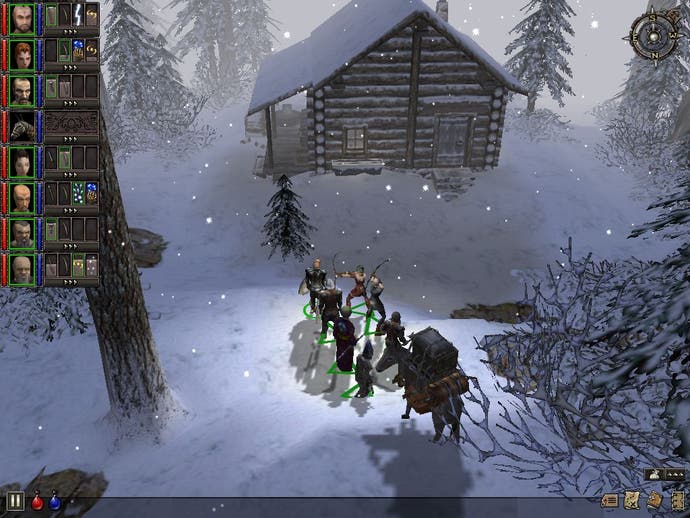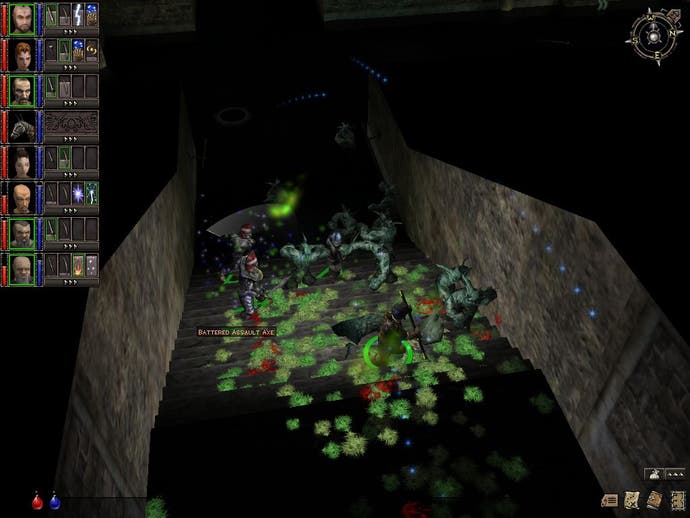Dungeon Siege
Review - Chris Taylor's much-hyped dungeon crawler gets the once over

Here Be McGuffins
Falling somewhere between the party-based antics of Baldur's Gate and the rapid fire click-fest that is Diablo, Dungeon Siege is a role-playing game for people who don't like to think. Characters, controls, stats-crunching and storyline are all pared down to the bare minimum, making way for an endless succession of increasingly brutal fights. There is a token plot, but it comes in uneven lumps and dull tomes, serving merely to keep you moving along in the right general direction, pushing you from one battle to the next. As the game begins the lead character is just a humble peasant, but a hammy voice-over assures you that you will soon be changing history, saving your kingdom from ruin, and all that jazz. Along the way you can gather up to seven companions, and in a novel twist this number can include pack mules to help lug your loot around, as well as the more usual warriors, wizards and archers. In the early stages of the game you won't be needing much direction from the plot though, because most of the world of Dungeon Siege is made up of slopes which are just that little bit too steep to clamber up, with long narrow valleys and claustrophobia inducing mines keeping you locked on a linear path. Later on in the game there are a few open areas, and if you hunt around there are some small hidden areas to uncover, but most of the time you don't have any opportunities for sight seeing. Instead you are neatly shuffled along a conveyor belt of restrictive caves and canyons, punctuated by towns where you can offload some of your ill gotten gains and pick up fresh supplies and additional characters...

I See Trees Of Green
This rather simplistic game structure would be fine if there was a dramatic storyline and involving characters to pull you into the game. Unfortunately the characters are all cardboard cut-outs with barely a line of dialogue to their name, and the plot is thin on the ground at the best of times. What little voice acting there is ranges from poor to downright insulting - whoever provided the voices for the miners should be rounded up and strapped to an electric chair for his troubles. Instead the game world takes center stage, and what a wonderful world it is. Dense forests, snow-shrouded mountains, eerily lit caves, misty swamps, and of course the eponymous dungeons are all lovingly rendered in real-time 3D, along with the nicely detailed and often bizarre looking monsters which inhabit them. Most impressive of all is the fact that this world is virtually seamless. There are no loading screens, and although occasionally when you arrive at a town the game will lock up for a second as data is pulled from your hard drive, most of the time the loading is done in the background without interrupting the flow. This allows you to move smoothly across a forest clearing, down a flight of stairs and into the dank crypt below, with the ground fading from view as you descend into the darkness. It's a neat trick, and helps to suck you into the world. The bad news is that the camera doesn't really let you zoom far enough out to fully appreciate this splendour, but you can get right up close to the action to see each swing of your sword and every drop of arterial spray that results from it. Sometimes the scenery gets a little overwhelming as well, and you can't see the forest (let alone your enemies) for the trees, but the foliage does at least fade out when it gets between your characters and the camera. An ugly overhead map can also be used to direct the battle if you can't see what your men are fighting behind all that shrubbery.

Autopilot
More often than not you won't need to do any directing though. Simply set all the AI options which govern how freely your characters should attack and chase enemies to maximum and the game will pretty much play itself. In the tougher battles you might want to switch your mages between healing and combat spells from time to time, while hammering on the H and M keys will order anyone in your party whose health or mana bar has dropped too low to quaff the appropriate potion. Otherwise you can cruise through 90% of the game on autopilot without having to actually do anything. You don't even need to spend your experience points, as Dungeon Siege uses a skill-based system whereby your characters get better at tasks as they carry them out. So if you spend all your time in melee, your melee combat and strength attributes rise automatically. Cast spells and your magic and intelligence stats gradually improve. While it's nice to see the developers automate tedious functions such as picking up loot and introduce decent AI and a novel character development system, in a game which is solely focused on combat this doesn't leave much for the player to do for themselves. Of course, you can manage your battles by hand, disabling the AI and pausing the game to give orders by hand, but this tends to be pretty futile and tactical possibilities are limited. Enemies run right through your men as if they were ghosts, so you can't defend your mages and archers by moving your heavy warriors up front. Instead battles tend to turn into chaotic brawls, with characters and monsters chasing each other around in circles and desperately healing their allies as enemies swarm over you, charging in from all directions.

Nice But Dim
It doesn't help that you can't split up your group. The camera is always locked on the character(s) you currently have selected, so if your party gets seperated you won't be able to see what they're all doing except via the hideous "megamap" view. Even this doesn't work properly though, judging which parts of the map you have uncovered by where the camera is placed. So again, if one character chases after a monster he can end up disappearing into the fog of war. All you can do then is select the errant character and give the camera a couple of seconds to move to him. This doesn't work while the game is paused, so in the meantime the rest of your party will decide that you have selected the wayward wanderer as their group leader, and drop whatever they were doing to run towards him. Not very clever. Multiplayer leaves you with just one character to keep track of, but this doesn't really hit the spot either. Thanks to the wonders of DirectPlay you can only have up to eight people in a game at once. Given that you're free to roam across a few square miles of terrain, even finding the rest of the players can take a couple of minutes if you join a game which is already underway. It doesn't help that you have no way of knowing exactly where they are until after you have chosen where to spawn into the game. Which is about par for the course really, as Dungeon Siege's online support is downright primitive. The server browser doesn't even list ping times, so joining a game is a bit like playing Russian Roulette - you have no way of knowing whether the game will be playable until after you have connected to the server. What a great idea that was.
Conclusion
Dungeon Siege can be fairly entertaining in short bursts, but given the total lack of plot and character development there's little to keep you playing in the long run except the promise of more pretty graphics, new trinkets and more powerful enemies to kill. That might be enough for some people, but given the repetitive and brutal nature of combat it wore thin for me after a while.
-
Dungeon Siege screenshots



